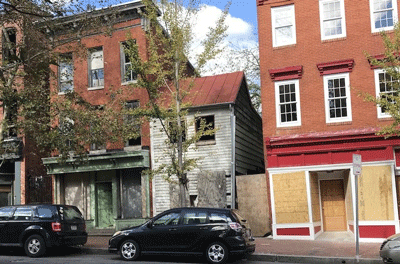The Southwest Partnership continues to step up its work to build what officials call an awesome community in Southwest Baltimore.
Executive Director Michael Seipp says among the more intriguing projects is the home that sits at 1504 West Baltimore Street. It is believed that the home dates back to the 1820s, which makes it among the oldest in the district. What’s more, it may be the only frame house in the area; and was once owned by Malachi Mills, a free African American carpenter.
“We’re turning it into a museum,” Seipp said of the historic landmark. “We have received grant money to stabilize it, and then we’ll have a fundraiser to help us turn it back to what it originally looked like.”
According to the Baltimore City website, the vast majority of existing residential structures in the Union Square district date to the period 1845 to 1880, with institutional and commercial buildings continuing to be added in the late 19th and into the 20th Century. The period of significance of 1820 to 1930 encompasses the range and location of housing for residents of a variety of socioeconomic circumstances and the institutions and businesses that served them.
In addition, the period captures the eras of Baltimore’s growth as it expanded from its original core around the Inner Harbor into formerly open spaces, transforming them into dense urban neighborhoods adjacent to burgeoning industries. The Mills house itself is rich with history.
“The Malachi Mills House is a unique Baltimore historic site both for its architectural features and for its social history. It’s one of the few— if not the last— wood-frame houses in West Baltimore; and one of the oldest buildings along W. Baltimore Street which historically has been a major commercial corridor,” Elizabeth Weber of the Southwest Partnership told ExploreBaltimore.org.
“The survival of the Malachi Mills House represents continuity through change along the corridor— a fixed point in an evolving neighborhood,” Weber said. “The Malachi Mills House offers insight into under-represented aspects of Baltimore’s history— the lives of craftspeople of color and their families in the early nineteenth century— as well as an opportunity to explore the history of W. Baltimore Street and the surrounding neighborhoods.”
Seipp says The Southwest Partnership is diligently working to secure more details about Mills. He further says the project should yield some of the more exciting finds in recent memory.
“We are researching Mr. Mills more extensively,” Seipp said. “We also have a design team working to recreate how the house would have been originally laid out, and we hope to have a clean title in the next couple of months. At that point, we will be able to move full steam ahead.
“The building definitely sticks out. We were very excited when we had the opportunity to save this piece of Baltimore history. As one of the largest populations of free blacks in the country, the contribution of these citizens is rarely told.”
